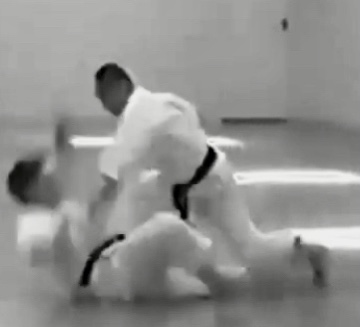To understand the 常行
(Joko) series of kata, designed by Asai Tetsuhiko Sensei, one needs to
understand their theoretical basis (pros and potential, not only potential but
real, cons); furthermore, the achievement objectives that they collectively set
out to attain.
There is an interesting story behind Joko that nearly
answers all of these questions—which I believe you will find is fascinating, if
not genius—and I’ll will outline this today.
Before doing so, for those who are less familiar with Asai
Sensei’s karate, I want to stress that “…the Joko series are not 古典型
(Koten-gata/Ancient/Classical kata, nor formulated/reverse engineered directly
from them) as often claimed”; rather, they are kihon training kata created by
Asai Sensei. Moreover, Sensei made them primarily ‘theme based’ for optimizing
the training of the foundational techniques; thus, while there are
applications, they are not so direct (but, rather, underpin actions). Taken as
a whole, “…the five Joko are ‘higher-level’ 順路
(Junro)”.
Ok, so now that is out of the way, allow me tell you a
fascinating story.
Asai Sensei was an avid reader, and if you ever visited him
at his company office—Futami Tsusho—in Shinbashi, he’d often visit the local
bookshop. He had a wide range of interests, one of which was classical music
which, again, he greatly enjoyed reading about.
That brings me to the Joko Kata. As you will probably know
the name Joko basically means ‘always do’ and the labels ‘Issei’ to ‘Gosei’
translates as (first to fifth) ‘energy’/‘force’/‘authority’/‘vigor’/‘influence’/or
‘impetus’. As I’ve stated in the past this kanji for 勢 (Sei)—for most Japanese—immediately
brings the power of physics to mind. In Asai Sensei’s terms ‘natural energy’.
All right, but that obviously still doesn’t provide the
complete story…. Allow me to link classic music, with these kata, via
Charles-Louis Hanon (1819 – 1900); in particular, his most famous publication:
‘Le Pianiste virtuose’ (The Virtuoso Pianist).
This classic piano textbook—first published in Boulogne, in
1873–is “…a compilation of sixty exercises meant to train the pianist in speed,
precision, agility, and strength of all of the fingers and flexibility in the
wrists.”
“The
exercises are intended to address common problems which could hamper the
performance abilities of a student. These include "crossing of the
thumb", strengthening of the fourth and fifth fingers, and quadruple- and
triple-trills. The exercises are meant to be individually mastered and then
played consecutively in the sections they are placed in. Apart from increasing
technical abilities of the student, when played in groups at higher speeds, the
exercises will also help to increase endurance.”
Here’s a quick summary of ‘Le Pianiste virtuose’… You’ll
notice, consistent with the aforementioned aims, it sounds like a karate
textbook!!!
Part One: Exercises 1 – 20 are "preparatory
exercises",
Part Two: Exercises 21 – 43 are referred to as ‘further
exercises for the development of a virtuoso technique’.
Part Three: Exercises 44 – 60 are high-level ‘virtuoso
exercises for mastering the greatest technical difficulties’.
Yes, this is all ‘kihon’ for pianists, nonetheless, it is
‘hard core kihon’. It is this work of Hanon—in its entirety—that ‘inspired the
Joko series of kata’ and sums up their purpose.
Does that mean the Joko kata are good for everyone? The
answer is clearly ‘No way!!!’. Interestingly, the same goes for Hanon’s 60
exercises. Many contemporary piano teachers claim that they are not good for
technique as they take up too much time. Furthermore, they insist—for the
person not seeking an ‘extreme level of technical skill’—believe it is better
to go straight to Mozart, Beethoven, Chopin et al.
This is the basis of Hanon’s exercises—extreme skill in the
‘basics’—and, indeed, the five Joko kata. Who would imagine that Hanon is an
influencer of Asai Sensei’s creativity and teachings? But he was! There are
other such situations as well, however, I’ll stick to Joko today.
Needless to say, this type of practice is not for the faint
hearted. It is ‘deliberate practice’ requiring deep mental concentration and
physical effort whilst simultaneously offering very little joy. To explain
this, the investment of training is very high and ‘the returns’/‘gains’ are
slow to come; that being said, if somebody wishes to get to a really
exceptional high level and is really tough, the investment is worth it.
To conclude, I really hope that this article was worthy of
your read. If you are interested in more information about Joko, here is
another article which will further your understanding: http://andrebertel.blogspot.com/2018/10/joko-issei-gosei.html


No comments:
Post a Comment